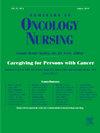Measurement of Patient-Reported Outcomes: The How, When, and Where
IF 2.3
4区 医学
Q1 NURSING
引用次数: 0
Abstract
Objectives
There is growing evidence that integrating patient-reported outcomes (PRO) into clinical assessments is associated with improved symptom management, patient satisfaction, and survival rates. This report aims to critically examine factors that influence how, when, and where PRO should be assessed in the cancer pathway.
Methods
This discussion is grounded in clinical research expertise and supported by relevant literature from peer-reviewed journals.
Results
Multiple digital methods for conducting PRO assessments are being used. Evidence increasingly suggests that adopting a hybrid approach is more likely to ensure that diverse populations complete PRO assessments. This will ensure the data generated are more representative of the wider cancer population. Most research focuses on assessing PRO during treatment while less focuses on the postsurgical and survivorship phases in the cancer pathway. During treatment, more frequent PRO assessment is more informative and better able to guide clinical decision-making. This, however, needs to be balanced against respondent burden. Matching the method for capturing PRO assessment to the preferences and requirements of respondents may be more important than the location in which it occurs.
Conclusion
Regular assessment of PRO improves patient outcomes during treatment and, based on the limited evidence available, following surgery and during the survivorship phase of the cancer pathway.
Implications for Nursing Practice
More research is needed to identify the optimal timing of PRO assessments during treatment to maximize information while minimizing respondent burden. Finally, we need to better understand which methods for capturing PRO assessments best meet the diverse personal requirements and preferences of the wider cancer population.
患者报告结果的测量:如何、何时、何地。
目的:越来越多的证据表明,将患者报告的预后(PRO)纳入临床评估与改善症状管理、患者满意度和生存率相关。本报告旨在批判性地研究影响如何、何时、何地在癌症途径中评估PRO的因素。方法:本讨论以临床研究专业知识为基础,并以同行评议期刊的相关文献为支持。结果:正在使用多种数字方法进行PRO评估。越来越多的证据表明,采用混合方法更有可能确保不同人群完成PRO评估。这将确保生成的数据更能代表更广泛的癌症人群。大多数研究侧重于评估治疗期间的PRO,而较少关注癌症途径的术后和生存阶段。在治疗过程中,更频繁的PRO评估信息更丰富,能够更好地指导临床决策。然而,这需要与答辩人的负担相平衡。将获取PRO评估的方法与受访者的偏好和要求相匹配,可能比评估发生的地点更重要。结论:定期评估PRO可改善患者治疗期间的预后,基于有限的证据,可改善手术后和癌症途径生存期的预后。对护理实践的启示:需要更多的研究来确定治疗期间PRO评估的最佳时机,以最大化信息,同时最大限度地减少被调查者的负担。最后,我们需要更好地了解哪种获取PRO评估的方法最能满足不同的个人需求和更广泛的癌症人群的偏好。
本文章由计算机程序翻译,如有差异,请以英文原文为准。
求助全文
约1分钟内获得全文
求助全文
来源期刊

Seminars in Oncology Nursing
Nursing-Oncology (nursing)
CiteScore
3.40
自引率
0.00%
发文量
68
审稿时长
45 days
期刊介绍:
Seminars in Oncology Nursing is a unique international journal published six times a year. Each issue offers a multi-faceted overview of a single cancer topic from a selection of expert review articles and disseminates oncology nursing research relevant to patient care, nursing education, management, and policy development.
 求助内容:
求助内容: 应助结果提醒方式:
应助结果提醒方式:


